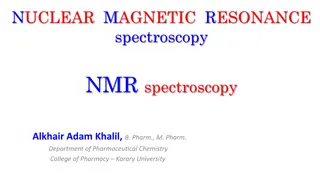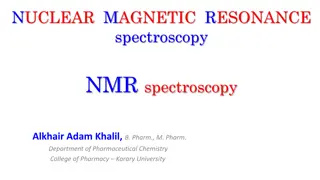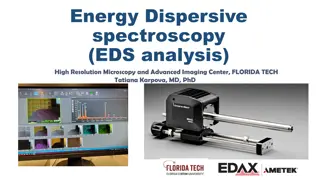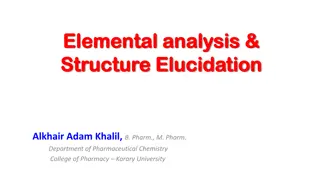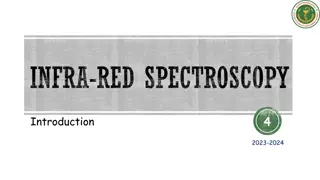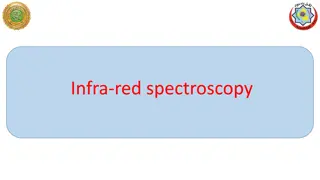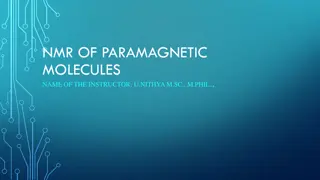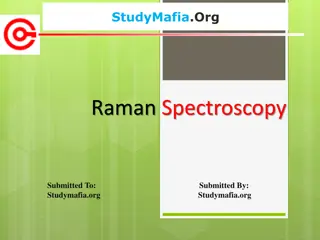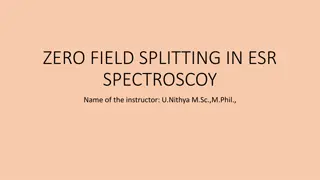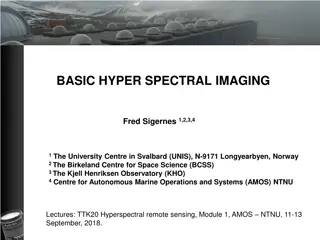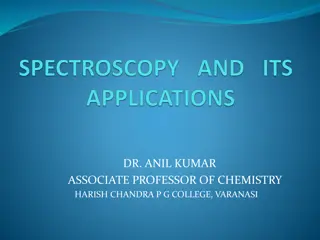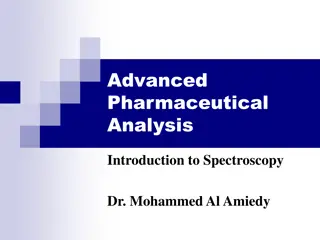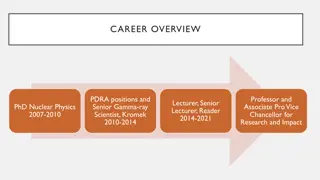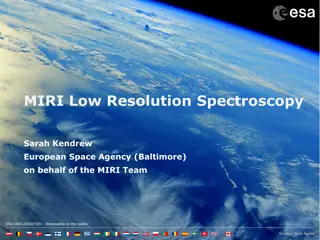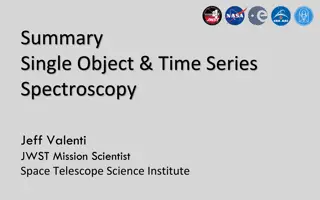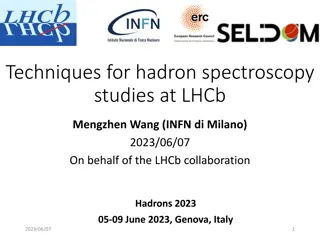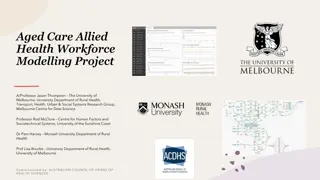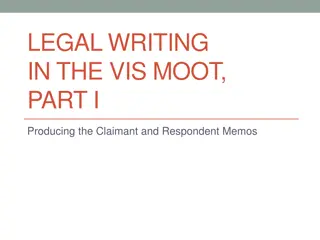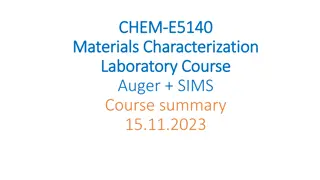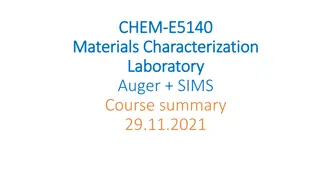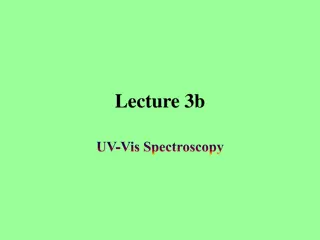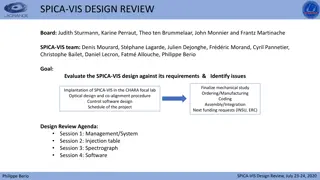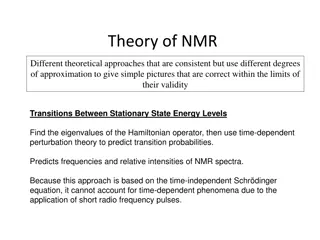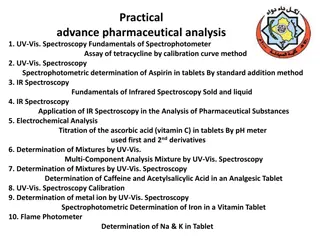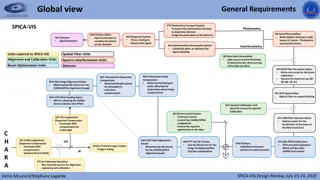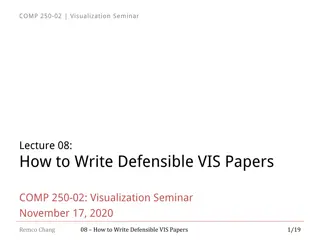Introduction to NMR Spectroscopy: A Powerful Tool for Structural Analysis
Nuclear Magnetic Resonance (NMR) spectroscopy is a vital technique in determining the structure of organic molecules. It complements IR and UV spectroscopies by providing a detailed map of the carbon-hydrogen framework. Understanding the physics behind NMR, such as nuclear spin and the effect of mag
6 views • 30 slides
Understanding NMR Spectroscopy for Structure Identification
NMR spectroscopy is a powerful tool in determining the structure of organic compounds. This summary outlines the process of using 1H NMR spectroscopy to identify an unknown compound, detailing steps such as determining different proton types, analyzing integration data, and interpreting splitting pa
3 views • 40 slides
Understanding Energy Dispersive Spectroscopy (EDS) in Microscopy
Energy Dispersive Spectroscopy (EDS) is a powerful X-ray microanalytical technique utilized in scanning and transmission electron microscopes to determine the chemical composition of samples. By analyzing the X-ray signals generated from interactions with the sample's atoms, EDS enables qualitative
8 views • 30 slides
Pascal's Rule in NMR Spectroscopy ( n+1 )
Pascal's Rule in NMR spectroscopy, also known as the (N+1) rule, is an empirical rule used to predict the multiplicity and splitting pattern of peaks in 1H and 13C NMR spectra. It states that if a nucleus is coupled to N number of equivalent nuclei, the multiplicity of the peak is N+1. The rule help
1 views • 30 slides
Elemental analysis & Structure Elucidation
Understanding elemental analysis and structure elucidation is crucial in chemistry. Learn the process, calculations, and methods involved, such as mass spectrometry, infrared spectroscopy, and nuclear magnetic spectroscopy. Discover how to determine empirical and molecular formulas using examples li
1 views • 27 slides
Understanding Molecular Vibrations and Infrared Spectroscopy in Chemistry
Molecular vibrations play a crucial role in the study of chemical compounds through infrared spectroscopy, where different modes such as stretching and bending of bonds are analyzed based on their energy levels. Infrared absorption leads to changes in dipole moments, affecting the reactivity of mole
1 views • 23 slides
Slitless Stellar Spectroscopy with the SA100 Grating Procedures
Explore the world of slitless stellar spectroscopy with the SA100 grating as detailed by Anthony Harding in the ongoing creation of the Harding Spectra Library. Learn about the equipment used, the process of determining instrument response, capture procedures, and stacking techniques for obtaining s
0 views • 30 slides
Understanding Infrared Spectroscopy and Molecular Vibrations
Exploring the fascinating world of infrared spectroscopy and molecular vibrations. Learn about the different regions of the infrared spectrum, Hooke's law, vibrational frequencies, and the types of molecular vibrations. Discover how bond strength, reduced mass, and wave numbers are interconnected in
0 views • 18 slides
Association of Renal and Cerebral Near-Infrared Spectroscopy with Adverse Outcomes in Single Ventricle Patients after Stage I Palliation
Study investigates the association between renal and cerebral near-infrared spectroscopy (NIRS) values and low cardiac output syndrome in single ventricle patients post Stage I palliation. Data from infants who underwent surgery between 2010-2019 is analyzed to determine correlations with adverse ou
0 views • 13 slides
Understanding NMR Spectroscopy of Paramagnetic Molecules
NMR spectroscopy of paramagnetic molecules is influenced by the presence of unpaired electrons, leading to broadened spectra and complex coupling mechanisms. Quadrupolar nuclei, with spins greater than 1/2, play a significant role in the relaxation and splitting of NMR signals. The interaction betwe
0 views • 19 slides
Understanding Raman Spectroscopy: Principles and Applications
Raman spectroscopy is a technique used for chemical analysis by exciting molecular vibrations with light. This inelastic scattering of light allows researchers to gather valuable information about samples. The method relies on the Raman effect, discovered by C.V. Raman, which involves the emission o
0 views • 14 slides
Understanding Zero Field Splitting in ESR Spectroscopy
Zero field splitting in ESR spectroscopy involves the relaxation times in ESR and how spin-lattice relaxation affects the spectral width. Discover how T1 value and spin lattice relaxation play a crucial role in observing sharp spectrum lines in EPR. Learn about line widths in ESR, spin dilution, and
0 views • 21 slides
Understanding UV/Visible Spectroscopy and Electromagnetic Radiation
Spectroscopy is the study of the interaction of matter with light, specifically UV and visible radiation. Electromagnetic radiation, consisting of photons, transmits energy through space as waves with oscillating electric and magnetic fields. The relationship between wavelength and frequency is key,
0 views • 50 slides
Understanding the Basics of 13C NMR Spectroscopy
Nuclear Magnetic Resonance (NMR) Spectroscopy is a powerful analytical tool used in chemistry to study the structure of molecules. This summary focuses on the application of 13C NMR spectroscopy, which provides valuable information about carbon atoms in a compound. The low natural abundance of carbo
0 views • 36 slides
Understanding Basic Concepts of Hyperspectral Imaging and Spectroscopy
Exploring the fundamental principles of hyperspectral imaging and spectroscopy, this content covers topics such as interference, diffraction, spectrometer workings using diffraction gratings, and wave properties. Lectures by Adjunct Professor Fred Sigernes delve into topics like basic spectroscopy,
0 views • 21 slides
Structural Elucidation of Chemical Compounds Using Spectroscopy Techniques
This presentation discusses the various types of spectroscopy techniques such as UV-Visible, IR, Raman, NMR, and others used for elucidating the structure of chemical compounds. It covers the identification of molecule shapes like AB2, AB3, and AB4, with a focus on linear and non-linear structures.
0 views • 18 slides
Understanding NMR Spectroscopy and Chemical Shifts
Nuclear Magnetic Resonance (NMR) spectroscopy is a powerful technique for analyzing molecular structures based on the chemical shifts of protons. In an NMR spectrum, peaks correspond to different protons in a compound, with their positions, intensities, and spin-spin splitting providing valuable inf
0 views • 19 slides
Association of Renal and Cerebral Near Infrared Spectroscopy with Low Cardiac Output in Single Ventricle Patients
Near-infrared spectroscopy (NIRS) has been studied in infants after Stage I palliation surgery to assess its association with low cardiac output and adverse outcomes. This retrospective study investigated postoperative cerebral and renal NIRS values in infants with single ventricle physiology. Resul
0 views • 13 slides
Spectroscopy and Pattern Recognition in Pharmaceutical Analysis
Understanding spectroscopy and pattern recognition in pharmaceutical analysis is crucial for interpreting 1H NMR spectra. Specific splitting patterns indicate the presence of various functional groups like ethyl, isopropyl, and tert-butyl. Recognizing these patterns aids in identifying compounds eff
3 views • 51 slides
Understanding Mass Spectroscopy and Magnetic Sector Design in MS
Introduction to Mass Spectroscopy (MS), key physics effects, magnetic sector MS design considerations, measuring mass/charge ratio, and using derived principles to scan a magnetic sector MS. Learn about the historical development of magnetic sector mass spectrometers and the first recorded MS spectr
0 views • 14 slides
Understanding Atomic Spectroscopy and Atomization in Analytical Chemistry
Explore the principles of atomic spectroscopy through examples and theories, focusing on topics such as the Boltzmann distribution problem and atomization processes using flames. Learn about the challenges and complications in atomization, including issues with nebulization efficiency and poor volat
4 views • 20 slides
Accomplished Career in Nuclear Physics and Gamma-ray Spectroscopy
Experienced professional with a diverse background in nuclear physics and gamma-ray spectroscopy. Successfully held positions including Senior Gamma-ray Scientist, Professor, Associate Pro Vice Chancellor, and more. Achieved significant milestones such as securing research funding, supervising PhD s
1 views • 4 slides
NMR Spectroscopy Lecture Highlights and Questions
Explore the world of NMR spectroscopy through a lecture covering theory, instrumentation, and the effects of the environment on spectra. Delve into questions on magnetic field drift, spin states, sensitivity, peak width resolution, and more. Discover the intricate details of modern NMRs and the impa
1 views • 17 slides
MIRI Low Resolution Spectroscopy Overview
Explore the design, operating principles, and performance of MIRI Low-Resolution Spectroscopy presented by Sarah Kendrew from the European Space Agency. Learn about the basics, design, focal plane layout, testing, and capabilities of the instrument through detailed images and descriptions.
2 views • 14 slides
Best Practices for Spectroscopy in JWST Missions
Explore key aspects such as wavelength coverage, spectral resolution, use of slits for faint targets, and choosing between different instruments like NIRSpec and MIRI for optimal results in time-series spectroscopy with JWST. Learn about the impact of apertures on precision and saturation limits for
0 views • 13 slides
Techniques for Hadron Spectroscopy Studies at LHCb
Hadron spectroscopy studies at LHCb focus on searching for new hadrons, measuring their properties like lineshape, lifetime, and decay modes. The LHCb detector is optimized for collecting, reconstructing, and identifying signals to improve knowledge about hadron spectroscopy. Development of data ana
0 views • 30 slides
Shadow Education and Educational Capitalism in Cambodia
Exploring the impact of shadow education on the nation-state in Cambodia, this analysis delves into the complex interplay between educational development, compulsory schooling, privatization practices, and the emergence of educational capitalism. It questions the traditional notions of nation-state
0 views • 8 slides
Addressing Allied Health Workforce Shortage in Australian Aged Care
Estimated shortfall of 25,000 Allied Health Care workforce by 2033 in Australian aged care system according to a commissioned report. Increasing training places and graduates by 3.5x from current levels is necessary to bridge the gap. The total number of eligible aged care service recipients is expe
0 views • 17 slides
Advances in Baryon Spectroscopy and Hadronic Matter Studies
Discussions at the meeting focused on interpreting HADES results for e+e- and meson production in hadronic reactions, with studies involving proton, pion, light, and heavy ion beams. The role of time-like electromagnetic transitions, baryon spectroscopy, and connecting hadronic matter studies were e
0 views • 12 slides
Insights into UV/VIS Backscattered Sun Light Retrievals from Space-Born Platforms
Explore the history, instruments, and future of UV/VIS backscatter spectrometers, including a comparison of TOMS and OMI systems, the GEO constellation, and examples of data retrievals. Dive into the discovery of the ozone hole and the advancements in atmospheric chemistry analysis by USA, Europe, a
0 views • 41 slides
Mastering Legal Writing in Vis Moot: Claimant and Respondent Memos
Learn the essential requirements for producing Claimant and Respondent Memos in the Vis Moot competition. Understand the strict deadlines, formatting guidelines, and the division of tasks within your team to ensure a successful submission. Draft your memos early, revise often, and collaborate effect
0 views • 10 slides
Auger Spectroscopy: Techniques and Applications in Materials Characterization
Auger spectroscopy, named after Pierre Auger, is a powerful technique for analyzing the surface composition of materials at the atomic level. This method involves the emission of Auger electrons and characteristic x-rays upon interaction with an electron beam. It offers high surface sensitivity, ena
0 views • 29 slides
Overview of Auger Spectroscopy in Materials Characterization
Auger spectroscopy is a powerful technique used for materials characterization, involving the emission of Auger electrons to analyze the elemental composition of a sample. Named after Pierre Auger, this method provides valuable information about the surface properties of materials. The technique is
0 views • 24 slides
Understanding UV-Vis Spectroscopy and Electronic Transitions
UV-Vis spectroscopy involves the absorption of electromagnetic radiation by molecules, causing electronic transitions. Different chromophores and conjugated systems determine the wavelength absorbed, with the Beer-Lambert Law essential for quantification. Specific compounds like caffeine showcase un
0 views • 12 slides
Understanding UV-Vis Spectroscopy and Electronic Transitions
UV-Vis spectroscopy involves studying the absorption of electromagnetic radiation by molecules, leading to electronic transitions. This process results in the excitation of electrons and can be observed through color changes. Different molecular structures exhibit unique absorption patterns, influen
0 views • 13 slides
SPICA-VIS Design Review Summary and Project Update
The SPICA-VIS Design Review held on July 23-24, 2020, aimed to evaluate the design against requirements, identify issues, and finalize the mechanical study. The agenda included sessions on management/system, injection table, spectrograph, and software. The team, led by Philippe Berio, is working tow
0 views • 4 slides
Insights into Theoretical Approaches in NMR Spectroscopy
Theoretical approaches in NMR spectroscopy encompass diverse methods, each with varying degrees of approximation but yielding correct results within their validity. Techniques such as transition probabilities using the time-dependent perturbation theory, Zeeman interaction for energy level transitio
0 views • 32 slides
Practical Advances in Pharmaceutical Analysis Using Spectroscopy Techniques
This comprehensive guide covers various spectroscopy techniques, including UV-Vis and IR spectroscopy, as well as electrochemical analysis and flame photometry, for pharmaceutical analysis. It delves into the fundamentals of molecular spectroscopy, discussing electromagnetic radiation, quantum energ
0 views • 19 slides
SPICA-VIS Photometry Transport System Overview
This detailed overview outlines the intricate components of the SPICA-VIS photometry transport system, including modules for photometry, interferometry, dispersion, signal detection, and more. Key elements such as the optical fiber feeding optics, polarization delay compensator, atmospheric dispersi
0 views • 21 slides
Writing Defensible VIS Papers: Tips and Guidelines
Writing a compelling visualization (VIS) paper requires more than just presenting research findings. This seminar by Remco Chang outlines the importance of building a strong argument, structuring arguments effectively, and using resources such as the Heilmeier Catechism and the VALT Prospectus. It a
0 views • 19 slides
